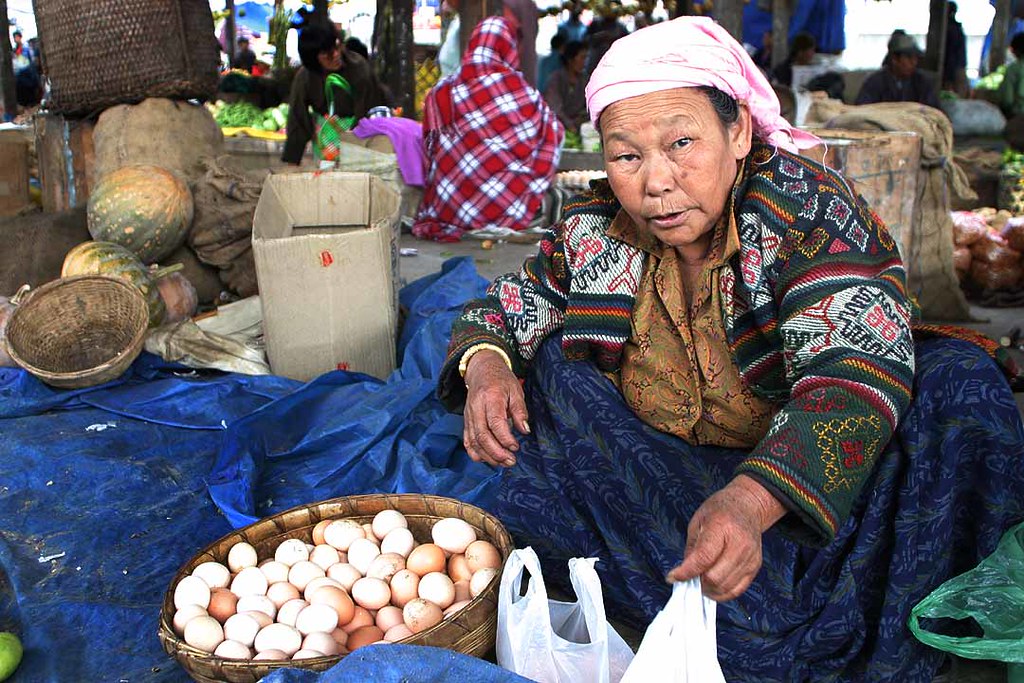Bhutan
Ramifications of the Tax Bill of Bhutan 2022

Local market in Thimphu
© By Steve Evans on Flickr (CC BY 2.0)Taxes are not new to Bhutan. Though tax in cash began only after the 1960s, people paid taxes in kind to several local chieftains, governors and religious bodies for centuries before the institution of the monarchy was founded on December 17, 1907. There are accounts of people leaving Bhutan for nearby Indian-occupied areas, unable to bear the burden of taxes. Thus, when the monarchy was established, it was the wish of the first King of Bhutan, Ugyen Wangchuck, to reduce taxes; of a similar mind, his heir, the Second King Jigme Wangchuck took on and abolished several taxes during his reign.
Fast forward a hundred years to where the current parliament of Bhutan, the third in line, has in its eighth session introduced and endorsed the Tax Bill of Bhutan 2022 in a bid to address the shortage of foreign currency reserves, prioritize the local sector (whilst substituting potential imports with local products) and encompass amendments to laws pertaining to Custom Duty (CD), Sales Tax (ST) and Green Tax (GT). The proposal from the Finance Ministry is to increase taxes on goods that are harmful to health and the environment while reducing taxes on essential commodities. The ministry has proposed 417 goods for tax revision, amendments in sales tax for 235 goods, a revision of custom duty for 165 items on and a green tax on 53 goods. Rice, wheat, oats, flour, cereals and buckwheat, amongst others, are some commodities that will attract 0% custom duty and sales tax, while tobacco-related items, juices, noodles, furniture and other commodities (including some harmful products) will see an increase in taxes. By increasing taxes on imported commodities that can be produced in the country, the government plans to increase demand for locally produced goods.
There are several factors that lead to a tax revision: the state of the post-COVID economy, the decline in foreign reserves, a fiscal deficit that has been increasing annually and more. Like that of other countries, Bhutan’s economy has been facing economic shocks from the COVID-19 pandemic and the Ukraine-Russia conflict. The value of the Ngultrum and Indian Rupee were depreciating against the dollar, and inflation was high at 7%. The National Statistics Bureau (NSB) of Bhutan, in its latest report (released on October 31, 2022,) reported that the purchasing power of the Bhutanese Ngultrum - as measured by the Consumer Price Index (CPI) - is Nu 60 as of September 2022 (relative to that in December 2012). The Purchasing Power of Ngultrum (PPN) as measured by the CPI has dropped by 5.31% in the past year (from August 2021 to August 2022) due to a price increase in the economy. The implication is that Nu 100 in September 2022 was worth only Nu 60 in December 2012 prices.
As a heavily import-dependent nation, Bhutan was going through its foreign reserves rapidly, a situation exacerbated by an increase in prices of consumer goods and services of 6.05% in September 2022 (as opposed to 4.97% at the same time the previous year). Inflationary pressures in the country were compounded by rising import prices for fuel and food. The inflation rate for food was 4.24%, while non-food items recorded an increase of 7.61% compared to August. During the observation period (from 1981 to 2021), the average inflation rate was 6.9% per year. Overall, the price increase was 1,259.72%. Transportation is the main driver of rising inflation, contributing to 37% of total inflation with a 14.92% increase, followed by food and alcohol beverages, which recorded a 4.42% increase and contributed 33% of total inflation. Clothing and footwear recorded the second-highest increase with 8.24%, contributing to 12% of overall inflation.
Tax revisions were considered a means to address these macroeconomic issues, especially the burgeoning trade deficit; the question was whether a reduction in taxes or zero-tax on essential goods would have the desired impact. According to the Department of Trade (DoT), Ministry of Economic Affairs (MoEA), the essential commodities list includes necessities and other goods like fuel, LPG, milk, flour, cheese, rice, edible oil, vegetables, fruits, noodles, eggs, mineral water, sanitary pads, baby diapers, cereals, butter, toiletries, salt, tea, coffee, sugar, soap, shampoo, toilet paper, detergents, pharmaceuticals, industrial raw materials and raw materials for hydropower construction. These are goods that are imported and whose prices are largely dependent on the Indian market. Though the Bhutanese government may not impose any other taxes after import, its people feel the effects of inflation. Further, Bhutan has no control over fuel prices. Fuel is essential, and when the price of diesel rises, the costs of transportation, etc. are transferred to the consumers.
The department currently does not have a list of non-essential commodities. Considering the government’s lack of delineation between essential and non-essential goods, it is difficult to determine what may be considered non-essential. Are television sets non-essential items? What about mobile phones and other technological gadgets that are ubiquitous and used by every individual, given the drive to digitize services and education in the country? Will these categorizations, like the moratorium on the import of vehicles, deter the purchase of such goods?
The Constitution mandates that Bhutan should have reserves of convertible currency that should meet the imports of one year, and the increase in taxes on goods that can be manufactured locally and considered non-essential is merely a stop-gap measure; clearly, there remains the need to look at this enduring and layered problem with reference to a long-term solution. As part of the revision of taxes for non-essential goods, the import of furniture draws a heavier tax; the rationale is that furniture can be manufactured in Bhutan. Though furniture can be (and is) manufactured locally, it carries a higher markup than imported furniture, owing to strict labour and conservation laws that increase labour and raw materials costs, etc., all of which are passed on to the consumer. When the rates of domestically produced furniture far exceed those of imports from India or China despite inferior quality and design, there is no argument as to which the common person will prefer. Taking such a choice away from the people should always be a short-term measure. To increase quality and decrease prices of locally manufactured products, a plethora of inherent issues in terms of policy, regulation and services must be addressed to foster innovation, creativity and growth.
It is apparent that growth in the private sector (with reference to local manufacturing) is dependent on cottage small industries (CSIs,): more than 95% of industry in the country belongs to the small and cottage category. According to the Department of Cottage and Small Industries (DCIS), there were about 26,116 CSIs as of June 2022. However, these numbers do not do justice to the economic potential of CSIs, which face challenges. Despite constituting a predominant percentage of industry in the country, CSIs contribute less than five percent to the gross domestic product (GDP). The sector has the potential to contribute up to 20% and provide substitutes for imports but is crippled by the lack of adequate capital, an enabling business environment, and an effective supply chain.
According to projections by the country’s central bank – the Royal Monetary Authority (RMA) - the tax revenue is expected to grow to 11.7% of the gross domestic product (GDP) in this fiscal year (FY). The projection is based on findings from the macro-economic framework coordination technical committee of the Finance Ministry as of October 2021 and included in the RMA’s annual report for 2021. The tax revenue is further projected to grow by 13.3% of the GDP in FY 2022-23 and by 13.9% in FY 2023-24. In FY 2020-21, the tax revenue collected was Nu 20.66B — 11.7% of the GDP — which indicates a decline of 9.4% from the previous FY. Of the total domestic revenue, tax revenue accounted for 57.6%.
Higher domestic revenue is important for a landlocked Bhutan, and its economic self-sufficiency has been a key government objective for decades. The constitutional mandate to bear expenses of all domestic expenditures through internal revenue makes collecting taxes vital. Having banked heavily on massive hydropower projects, which have shown recurring losses in the past few years, and the tourism and hospitality industries, which have been impacted of late by policy changes, there is a growing sense of doubt in Bhutan about the way it ought to navigate its financial journey in the longer run.
The pandemic years ushered a transformation never seen before in Bhutan, with massive changes in every sector. Bhutan graduates from the LDC in 2023, which will inadvertently place scrutiny on the capacity of its civil services and private and corporate sectors; it’s purely its ability to succeed in the face of such changes that will determine the fortunes of its people.
